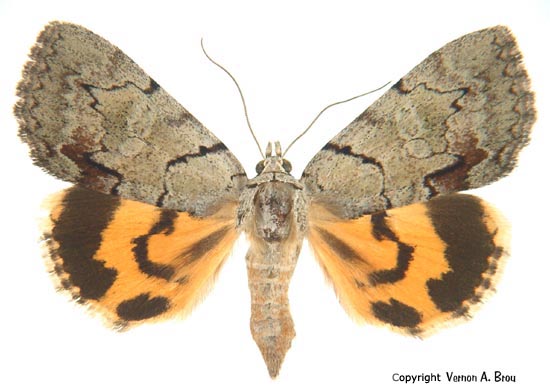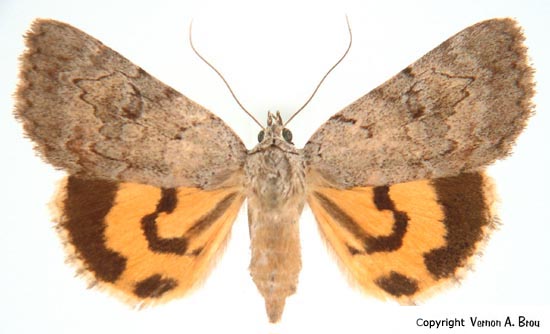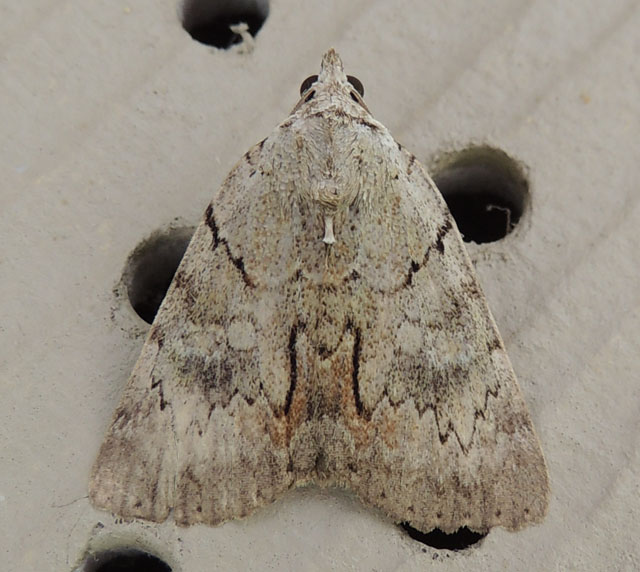Catocala alabamae
kah-TOCK-uh-lahMal-uh-BAM-ee
Grote, 1875

Catocala alabamae, Louisiana,
courtesy of Vernon A. Brou.
This site has been created by
Bill Oehlke.
Comments, suggestions and/or additional information are welcomed by Bill.
| TAXONOMY:
Superfamily: Noctuoidea
Family: Erebidae, Leach, [1815]
Subfamily: Erebinae, Leach, [1815]
Tribe: Catocalini, Boisduval, [1828]
Genus: Catocala, Schrank, 1802
|
DISTRIBUTION:
Catocala alabamae, the Alabama underwing, (wingspan: 30-40mm) flies from Maryland ?? south to
Florida,
west to Texas and north to Missouri and
Wisconsin ?? and
Illinois.
It has also been reported in
Alabama,
Arkansas,
Delaware,
Georgia,
Kansas,
Kentucky,
Louisiana,
Mississippi,
New York,
Ohio,
Oklahoma,
Pennsylvania and
Tennessee.
The listings for Maryland and Wisconsin are unconfirmed. I suspect it flies there and also in Indiana.
Titania (wingspan: 20-35mm) has recently been reclassified (synonymized with) as
alabamae and seems to have a more northern range with specimens taken in Pennsylvania. Alabamae has heavier, darker markings on the forewings and
hindwings.
The uniform greenish-grey forewing may have thin but dark (contrasting) medial lines
or they may be nearly absent (titania); alabamae often
displays a dash in the median/anal angle area, missing or nearly absent in titania.
There is brown shading between the post medial line and the subterminal line.

Catocala titania = alabamae by Vernon A. Brou.
Vernon Brou writes, "Catocala alabamae can be almost
non-distinguishable from charlottae. In some specimens here at my home in Louisiana, alabamae's
forewings are silver. Closer to Florida and in Florida some populations have forewings that are nearly pastel green.
"Here in Louisiana, alabamae's forewings can be silver to blue-green. It is possible C. charlottae will be
synonomized or made a subspecies of C. praeclara when the MONA Catocala fascicle finally is published."
The outer fringe of the hindwing is pale orange and heavily checked with black.

Catocala alabamae, Liberty, Liberty County, Texas,
June 7, 2013, courtesy of Stuart Marcus.
Olivia has recently been synonymized with Catocala alabamae.

Catocala olivia = alabamae, Louisiana, courtesy of Vernon Antoine Brou
FLIGHT TIMES AND PREFERRED FOOD PLANTS:
Catocala alabamae are usually on the wing from April-May (Texas) to June, July and August elsewhere.
The Catocala alabamae caterpillar shows a preference for hawthorns, wild crabapple and Chickasaw plum.
ECLOSION:
Adults eclose from pupae at soil surface.
SCENTING AND MATING:
Catocala alabamae females emit an airbourne pheromone and males use their antennae to track the
scent plume.
EGGS, CATERPILLARS, COCOONS AND PUPAE:
Eggs are deposited on tree/bush bark in the fall and hatch the following spring.
Larval Food Plants
Listed below are primary food plant(s) and alternate food plants. It is hoped that this alphabetical listing followed by the common
name of the foodplant will prove useful. The list is not exhaustive, although some species seem very host specific.
Experimenting with closely related foodplants is worthwhile.
Crataegus
Crataegus calpodendron.....
Malus coronaria
Prunus angustifolia
|
Hawthorn
Red haw/Pear hawthorn/Urn-tree haw
Wild crab apple
Chickasaw plum
|
Return to Main Index
This page is brought to you by Bill Oehlke and the
WLSS. Pages are on space rented from Bizland. If you would like to become a "Patron of the Sphingidae/Catocala Sites", contact Bill.
Please send sightings/images to Bill. I will do my best to respond to requests for identification help.
Enjoy one of nature's wonderments: Live Saturniidae (Giant Silkmoth) cocoons.

|

To show appreciation for this site, click on the flashing
butterfly to the left, a link
to many worldwide insect sites. |





